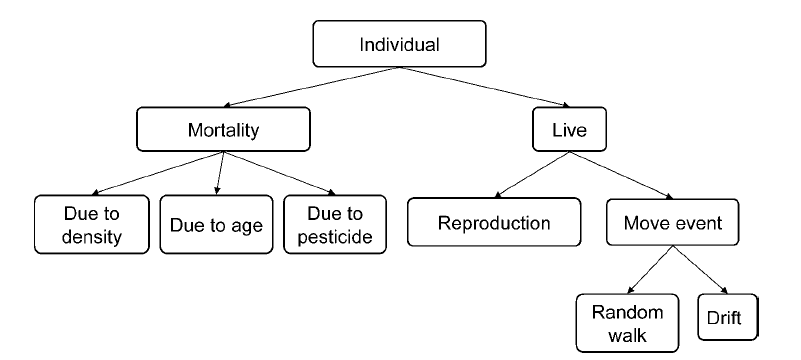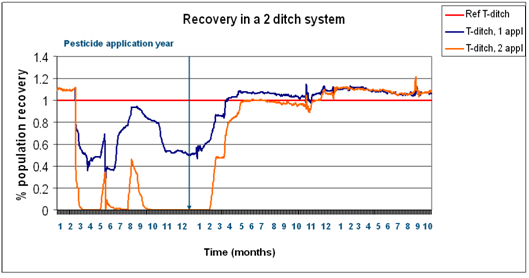
|
Mastep |
Because you have no Flash-player installed on your computer, you get to see a simplified version of our menu |
| MASTEP stand for Metapopulation model for Assessing Spatial and Temporal Effects of Pesticides. The model is a metapopulation model describing the effects and recovery of invertebrates after exposure to pesticides as a result of spray drift. The model is currently parameterised for the waterlouse Asellus aquaticus but more species with different life-cycle characteristics will be added in 2006. It is able to evaluate the effects on and recovery of the species using the pond, ditch and stream FOCUS scenario. The model can use the FOCUS exposure modelling using the use patterns, the FOCUS spray drift data and the fate model TOXSWA as input for exposure data. The modelled landscape is represented as a lattice of connected cells, which have a dimension of 1 by 1 meter. The structure of the landscapes is defined according to the FOCUS scenarios for pond, ditch and stream. |
The pond consisted of 30 by 30 cells with an in- and out-flow.
The pond and ditch scenarios were 600 cells long, of which a stretch of 100 cells were treated.
The model includes processes of mortality, life history, random walk between cells,
density dependence of population regulation and, in case of the stream scenario, medium-distance drift of invertebrates due to flow velocity.
All parameter estimates currently included were based on expert judgment and the results of a thorough literature review on published information on the ecology of Asellus aquaticus covering the last 50 years.
DemoFor Asellus aquaticus is a demo-model available here |
|
The processes included in the model were reproduction,
mortality, and movement or dispersal, see figure below.
|
AimPopulations in their natural habitats are frequently affected by various disturbances, both of natural and anthropogenic character. It is resistance to as well as recovery from disturbance that determines the relative stability of populations, communities and ecosystems. Chemical disturbance is only one of potential disrupting events caused by human activities. Pesticides are used worldwide to increase crop yield and, although becoming very pest-specific, still do affect non-target organisms in areas |
adjacent to treated crops. What makes certain species recover more successfully than others are specific life-history traits, such as number of reproductive cycles per year (from one to multiple), overall fecundity, dispersal that can be active or passive (via air, land or water), feeding strategies, but also individual sensitivity to the toxicant affecting them. The last point we consider is the role landscape features have in the recovery process of a certain species, where isolation or connectivity of an affected habitat patch will determine the speed of recolonization |
ApproachWe investigate what combination of life-history traits, landscape characteristics and pesticide application regimes (as well as mode of action) allows for population recovery by means of an individual-based model (IBM). |
IBMs look into the individual organism as the main unit of the population, while population characteristics are obtained through keeping track of intraspecific interactions as well as interactions with the environment. |
|
Example of population recovery in an aerially dispersing species; blue line denotes a system with a single pesticide application, orange line is a 2 pesticide application system. Recovery assumed if populations reach the red line, i.e. the reference population. |

|

